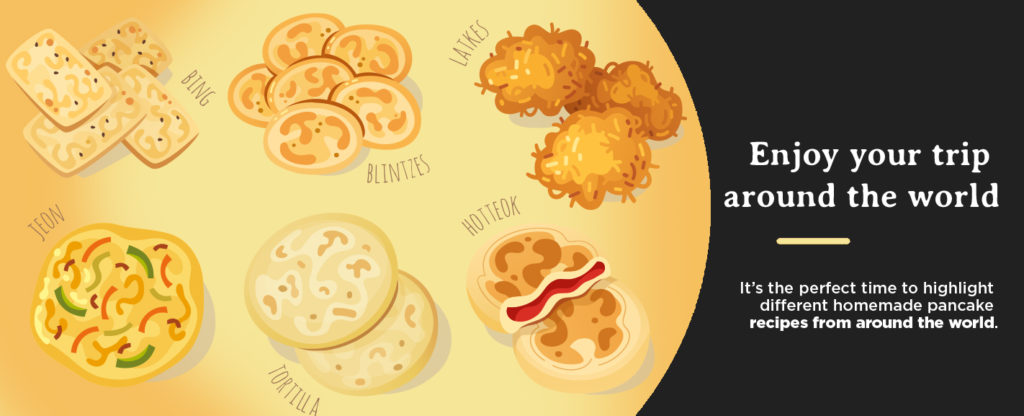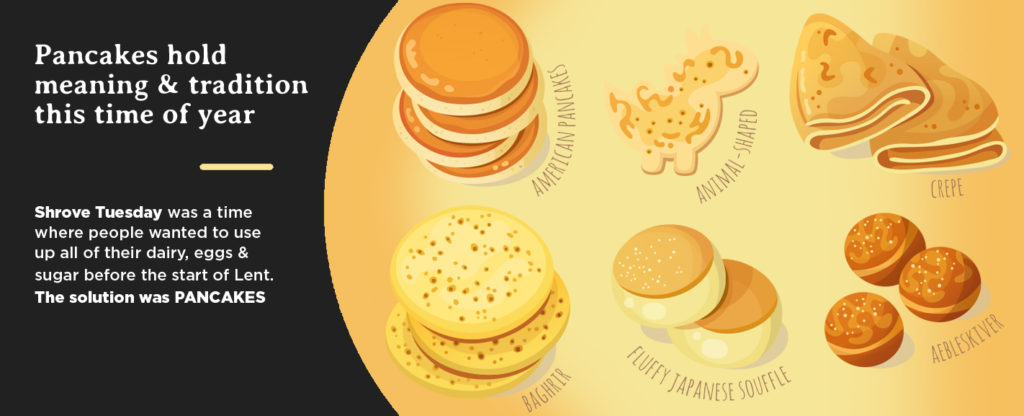Pancakes Around the World
February is National Pancake Month
Pancakes hold significant meaning and tradition this time of year. Shrove Tuesday, also known as Fat Tuesday and the celebration of Mardi Gras, is the day before Ash Wednesday. Ash Wednesday is the start of Lent, or the time of fast that many Christian denominations practice in preparation for Easter. Shrove Tuesday was a time where people wanted to use up all of their dairy, eggs and sugar before the start of lent. The solution was pancakes! Pancakes used up all of those ingredients and were a sweet treat before their 40 day fast. This started the Mardi Gras tradition of eating pancakes.
So, now is the perfect time to highlight different homemade pancake recipes from around the world. Each recipe will have a short description of the origin and significance of the pancake in that country. Food is an incredible way to celebrate and learn about other cultures. These different pancakes range from sweet to savory, appetizer to dessert, and local to global.
Some of these are also vegan pancakes! Dietary notes, such as vegan, vegetarian, or gluten-free) will be placed before the ingredient list. Make sure to take some pictures of your creations to celebrate and share with friends, even if it is virtual! Show off your food photography skills.
Almost all of these ingredients are available through Feeser’s. Search for ingredients here to see the entire Feeser’s catalogue. Please enjoy your trip around the world, stopping in every continent, through the universal love language of food.
Buttermilk Pancakes from the USA
The pancake we all know and love. This fluffy pancake will never disappoint. Perfect for breakfast, lunch or dinner. They can be topped with butter and syrup, peanut butter and bananas, berries, or anything!
Ingredients
- 1 ¼ cups milk
- 2 eggs
- 2 tablespoons vegetable oil
- 2 cups Gold Medal All-Purpose Flour
- 2 tablespoons sugar
- 3 teaspoons baking powder
- ¼ teaspoon salt
Directions
Brush nonstick griddle or skillet with vegetable oil, or spray with cooking spray before heating. Heat griddle or skillet over medium-high heat (350°F). In large bowl, beat milk, eggs and oil with whisk until well blended. Stir in remaining ingredients just until flour is moistened (batter will be slightly lumpy). Pour batter by 1/4 cup onto hot griddle. Cook 1 to 2 minutes or until bubbly on top and dry around edges. Turn; cook other side until golden brown. Serve warm.
Crepes from France
A list of pancakes from around the world would not be complete without the Crepe. Crepes date back to the early 13th century in Brittany, France. Their versatility allows crepes to be savory or sweet, and a meal or a snack. Their crispy edges are irresistible.
Ingredients
- 3 Tablespoons unsalted butter, plus 3-4 more Tablespoons for the pan
- 1 cup Gold Medal All-Purpose Flour
- 1 Tablespoon granulated sugar
- 1/8 teaspoon salt
- 3/4 cup whole milk, at room temperature*
- 1/2 cup room temperature water
- 2 large eggs, at room temperature
- 1 and 1/2 teaspoons pure vanilla extract
Directions
Melt 3 Tablespoons of butter in the microwave or on the stove. Cool for about 5 minutes before using in the next step. The remaining butter is for the skillet. Combine the cooled melted butter, flour, sugar, salt, milk, water, eggs, and vanilla to a blender or large food processor. If you don’t have a blender or food processor, use a large mixing bowl and whisk by hand. Blend on medium-high speed for 20-30 seconds until everything is combined. The mixture will be silky smooth and the consistency of cream. Cover the blender tightly or pour into a medium bowl, cover tightly, and chill in the refrigerator for 30-60 minutes and up to 1 day.
Use the remaining butter for greasing the pan between each crepe. Place an 8-inch skillet over medium heat and generously grease it with some of the reserved butter. If you don’t have a skillet this size, use a larger one but make sure you keep the crepes thin. Once the skillet is hot, pour 3-4 Tablespoons of batter into the center of the pan. Tilt/twirl the pan so the batter stretches as far as it will go. The thinner the crepe, the better the texture. Cook for 1-2 minutes, then flip as soon as the bottom is set. Don’t wait too long to flip crepes or else they will taste rubbery. Cook the other side for 30 seconds until set. Transfer the cooked crepe to a large plate and repeat with the remaining batter, making sure to butter the pan between each crepe. If desired, separate each crepe with parchment paper so they do not stick together. Fill the crepes. Place a few spoonfuls of your filling ingredient(s) in the center of the crepe. Fold both sides over the filling. Crepes are delicious with toppings, too, such as a drizzle of melted chocolate, melted peanut butter, or a dusting of confectioners’ sugar. Or a savory sauce like pesto or hollandaise. Leftover unfilled crepes remain fresh in an airtight container in the refrigerator for 1 day or in the freezer for 1 month. Freeze each between small sheets of parchment paper so they don’t stick. Thaw at room temperature before filling/enjoying.
Africa, Canjeero from Somalia
The Canjeero is most prominent in Somalia, Africa. It is one of the most common breakfasts in Somalia. The pancakes are topped with butter or ghee and sprinkled with sugar. The canjeero can be adapted for lunch and dinner by serving with meat or curry. There are similar versions of the Canjeero across Africa and in Southwest Asia, such as the anjero or the laxooh. Vegan
Ingredients
- 1 cup white corn flour
- ½ cup sorghum flour
- 1 Tbsp Instant dry yeast
- 4 cups Pillsbury Self-Rising Flour
- ¼ cup sugar
- 1 tsp salt
- 4 cups lukewarm water
Directions
In a large bowl, mix the white corn meal, sorghum flour, yeast and half of the water, making sure it is properly combined. Leave for one hour. After one hour add in the self-rising flour and sugar, then slowly start adding the remaining water as you mix to get a smooth, lump-less texture for your batter. The key to achieving the classic anjero taste is fermentation. The mix should rest in a warm place to allow the fermentation to take place. The minimum time would be a few hours but to achieve a more authentic, sour anjero taste, you can let the batter ferment for up to two days. For this recipe you can let the batter ferment overnight. In a non-stick frying pan on a medium heat, ladle the batter mix into the pan according to preferred portion size, making sure that the batter spreads fully across the surface of the pan. Cover the pan and cook for a few minutes per portion. The desired color is a golden brown, and the texture should be spongy with no liquid remaining. Plate the pancake and continue process until you each person has 3 each. Refrigerate leftover batter and use for lunch or for tomorrow’s breakfast.
Asia, Okonomiyaki from Japan
The Okonomiyaki is a savory pancake that is popular in Japan. It is typically made with cabbage, scallions, and assorted meat or seafood. The name originates with “Okonomi,” which means “what you like” and “yaki,” which means grilled. This Japanese Pancake is a delicious meal that anyone can make the how they please!
Ingredients
- 1 cup water
- 1 tsp konbu dashi stock powder
- 1 ¼ cups Gold Medal All-Purpose Flour
- 4 eggs
- 1/4 tsp salt
- 1/4 tsp sugar
- 6 ¾ cups finely chopped cabbage
- 4 cups chopped green shallot
- 1 ½ oz Tenkasu
- 1/3 lb thinly sliced pork
- bonito flake to garnish
- pickled ginger to garnish
- Aonori to garnish
- 1 tbs olive oil
- 1/4 cup okonomiyaki sauce
Directions
Dissolve the dashi powder into the water to make the dashi stock. Place the flour in a large bowl and add salt, sugar, and pour the dashi stock in to mix. Set aside. Divide the chopped cabbage, green shallots, and tenkasu into 4 small mixing bowls. Add one egg each and 1/4 of flour and dashi mixture to each bowl. Mix them well together with a fork. Heat cooking plate to 200 degrees and pour the cabbage mixture onto the cooking plate to spread approximately 2cm thickness. Place the thinly sliced pork and bonito flake on top of the cabbage mixture. When the edge of the okonomiyaki has become firm and cooked, flip it over with two egg flippers. Put the lid on and steam grill for a few minutes. Turn the okonomiyaki over one more time to check whether the meat is cooked. Brush the okonomiyaki with Okonomiyaki sauce and garnish with pickled ginger, more bonito and sprinkle aonori to serve.
Down Under, Pikelet from Australia and New Zealand
The pikelet is common in Australia, New Zealand, and Britain. This pancake is smaller and thicker than a crape. It is served similarly to a Buttermilk Pancake- with fruits, jam, cream, butter, syrup, chocolate sauce, icing sugar or standard sugar. These fluffy pancakes will be a hit! Vegetarian
Ingredients
- 1 cup Gold Medal All-Purpose Flour
- 1 teaspoon baking powder
- ¼ teaspoon baking soda
- ¼ cup caster sugar
- 1 egg lightly beaten
- 1¼ cup milk
- 2 tablespoons butter melted
Directions
Sift the flour, baking powder and baking soda together in a bowl. Add the sugar. Create a well in the center. Gradually add the egg and milk, then stir. Set aside for 15 minutes. Heat a large non-stick skillet over medium heat. Brush the bottom of the pan with melted butter. Depending on the size of the pan, pour 3 to 6 large spoons of batter, spacing them out so that you can spread them out. Cook for 1 to 2 minutes, until bubbles appear on the surface. Turn them over and cook for another minute, until golden. Brush the pan with a little melted butter between each batch of pikelets. Serve hot with strawberry jam and/or whipped cream.
Europe, Boxty from Ireland
The boxty is the famous pancake of Ireland. There are many different adaptations of boxty, but they all contain finely grated potato. While these potato pancakes are enjoyed all year round, they are most widely served in celebration of Saint Brigid’s day, the Patron Saint of Dairy. Vegetarian and Gluten Free
Ingredients
- 1 ½ cups grated raw potatoes
- 1 cup Gold Medal All-Purpose Flour
- 1 cup leftover mashed potatoes
- 1 egg
- 1 tablespoon skim milk
- salt and pepper to taste
- ¼ cup olive oil
Directions
Toss the grated potatoes with flour in a large bowl. Stir in mashed potatoes until combined. In a separate bowl, whisk together the egg and skim milk; mix into the potatoes. Season to taste with salt and pepper. Heat the olive oil in a large skillet over medium-high heat. Drop in the potato mixture, forming patties about 2 inches in diameter. Fry on both sides until golden brown, 3 to 4 minutes per side. Drain on a paper towel-lined plate. Serve warm.
North America, Rompope Pancakes from Mexico
While these are pancakes are typically a holiday treat in Mexico, they can be enjoyed any time of year. Rompope, or eggnog, pancakes are a sweet and simple treat that are sure to be a hit. Vegetarian
Ingredients
- 2 cups cup Gold Medal All-Purpose Flour
- 4 teaspoons baking powder
- 1/2 teaspoon salt
- 1/2 teaspoon ground cinnamon
- 2 cups eggnog
- 2 large eggs
- 3 tablespoons butter, melted
- 1/2 teaspoon vanilla extract
- syrup, for serving
- non-stick cooking spray
Directions
Preheat griddle. Whisk together flour, baking powder, salt, and cinnamon. In a separate mixing bowl, whisk together rompope or eggnog, eggs, butter and vanilla until well blended. Pour wet mixture into dry mixture and mix until combined. Liberally spray griddle pan. Pour a heaping 1/3 cup batter onto griddle using the back of the spoon to spread batter into a round. Cook until bubbles form, about, 1 to 2 minutes. Flip, cook until browned, 1 to 2 minutes more. Transfer to a baking sheet or platter; cover loosely with aluminum foil, and keep warm in oven. Continue with more oil and remaining batter. Serve warm, with syrup.
South America, Arepas from Venezuela
Arepas originate in Venezuela and Columbia. Archeologists have found that these delicious arepas have been made for over 3000 years! The process of eating arepas with others is symbolic of unity. This is also a gluten-free pancake recipe! Vegan and Gluten Free
Ingredients
- 2 ½ cups lukewarm water
- 1 teaspoon salt
- 2 cups pre-cooked white corn meal (such as P.A.N.®)
- ¼ cup vegetable oil, or as needed
Directions
Stir water and salt together in a bowl. Gradually stir corn meal into water with your fingers until mixture forms a soft, moist, malleable dough. Divide dough into 8 golf ball-size balls and pat each one into a patty about 3/8-inch thick. Heat oil in a skillet over medium heat until shimmering. Working in batches, cook corn patties in hot oil until golden brown, 4 to 5 minutes per side. Transfer cooked arepas to a paper towel-lined plate to drain until cool enough to handle. Slice halfway through each cake horizontally with a thin serrated knife to form a pita-like pocket.
More Global Pancakes
More about Pancakes, Biscuits, Pies & Scones from our Friends at General Mills
For information or to order any of the products in this publication, contact our Sales Team at 1-800-326-2828.



